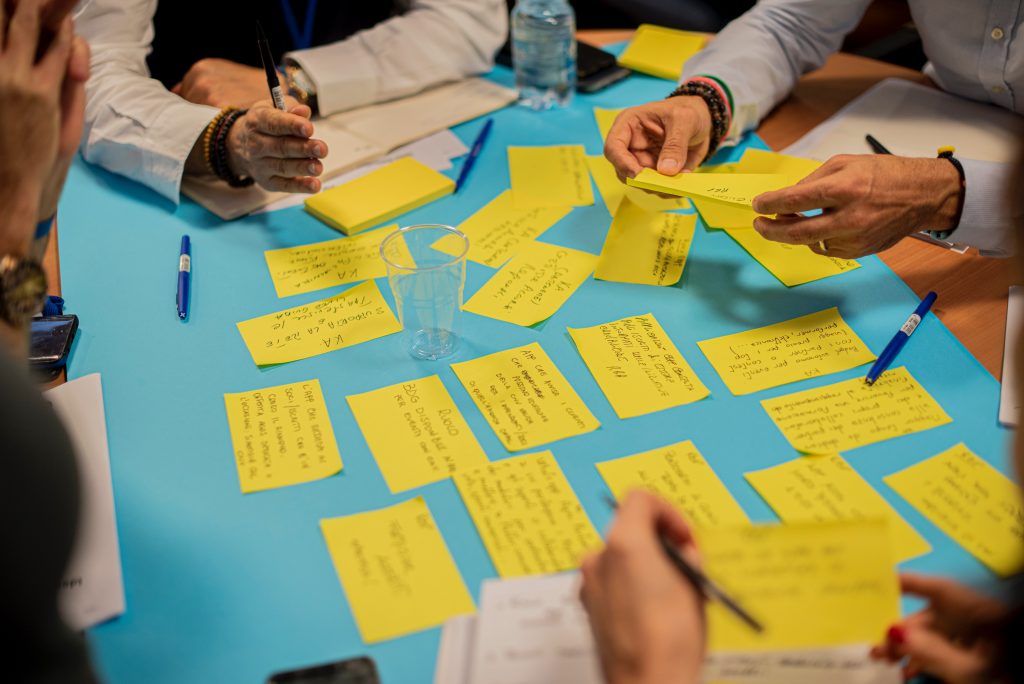
After our first round of icebreaker games, we came up with some new ones. Some were especially designed to be used with our teamshufflr app and some we just really like to do, because they are fun. Again, we’ve divided the concepts into ones that can be used both online and offline and ones where an offline setting is preferred to make this icebreaker work well.
We hope this collection helps you to ease into any workshop setting. And if you have any feedback regarding this collection, please let us know!
Icebreaker games for online & offline settings
Shufflr Stories
For this Icebreaker uniquely developed for our teamshufflr app, you take the cards specifically made with the app (or the online-version if you are in an online-setting) to divide attendees into groups of three to five people. At the same time, you need to set the group size to one for the “Icons” feature in the tool, so that a randomly assigned icon can be found on each card. The participants come together in the assigned groups – you can use the breakout-function of your conferencing tool in an online-setting – and now need to build a story from the randomly assigned icons. One person starts telling a story containing the icon on their card in one sentence, which is then continued by the next person with the next icon.
Stories can range widely from “A magnifying glass was floating in space. Then came a car zipping by, which was driven by an android bot, going to a conference on wifi” – or any other setting. That should really get the creative juices of the participants flowing! At the end, each group gets to briefly present their icon sequence and the story that goes with it – so everyone can have a good laugh.
Assign attributes
This game is fun as it is based on the first impressions of people in a group. Every person anonymously writes down 2-4 attributes with which they would describe themselves. The attributes of all people are put together, mixed, and then distributed around the table. Then, the group gets to vote, which attributes were written down by whom – usually centered on the person (e.g. “Now we vote which two attributes you think Bob wrote down”). After each vote, the person reveals who guessed right – smart people will remember the right ones and guess right more often, the longer the game goes on. But that should not diminish the fun in it.
Five-Star-Menu
Divide participants into groups of 3-5. Each participant names their favorite food for one of the courses of a meal – the meal has as many courses as there are team members in each team. So Bob names as an entree: cheese soup. Then Mary continues with a fruit salad, the main course is contributed by Pat, who likes Pizza a lot. And in the end we’ll have Tom’s favorite sweet as a dessert – gummy bears. At the end of this icebreaker game, each group presents their five star menu and everyone has a good laugh. If you have more time, you can use the concept also for an extensive teambuilding activity.
Icebreaker games offline settings only
Human knot
You need groups of at least 4 people for this game. The people stand in a circle, and every participant reaches out with their right hand to grab the hand of another person across the circle. Afterwards, the left hand grabs the open hand of another person. The people then have to untangle the knot without breaking the chain of hands. If someone during this process let’s go of one hand, they have to start over.
Whisper down the lane
For this game, you’ll need a few materials, for example a couple of lego bricks. You can use teamshufflr to split the people in groups of 3-4. Each group gets assigned a randomly built lego structure (with 10-12 bricks), and a second set of the exact same type of bricks. The challenge is to replicate the given structure as accurately as possible. But only one person of each team is allowed to see the structure.
This person has to describe it to the second person and how they should place the bricks (“Our structure has a yellow 10×2 lego brick as a base, with a red 2×1 brick on top in the third row”). The second person then tries to repeat these instructions to the 3rd and 4th person, which places the given bricks. The point of this game is to challenge the communication skills of the participants. If you want to improve the difficulty of this challenge, you can let the people speak in a foreign language (preferably one everybody is more or less fluent in).

